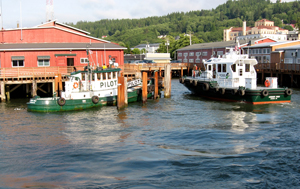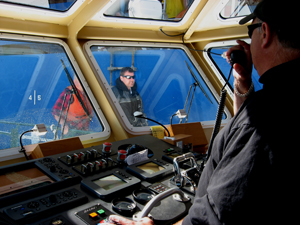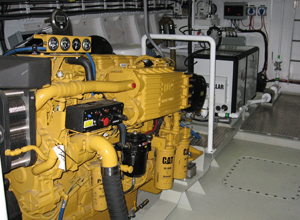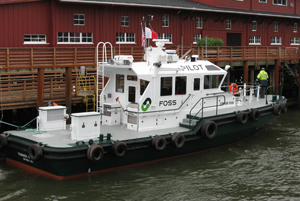The notorious Columbia River bar is one of the most dangerous river entrances in the world, and it’s just the first of many navigational hazards that ships face on the dredged, 43-foot channel that extends 100 miles upriver to the ports of Vancouver, Wash., and Portland, Ore. Two pilotage associations, the Columbia River Bar Pilots and the Columbia River Pilots, have cooperated for years to provide a seamless service to visiting vessels, which now total more than 2,000 annually.
The Bar and River pilots make their exchange off the Astoria waterfront at river mile 15 via a launch service provided by local tug operators. Since 1993, this has meant Foss Maritime, whose acquisition of Brix Maritime included Arrow No. 2, a traditional 52-foot by 14-foot steel harbor launch built in 1960. Despite its lack of comfort and sophistication, Arrow No. 2 survived into the 21st century, becoming a sentimental favorite for the latest generation of pilots and operators.
 |
|
After 50 years of service, Arrow No. 2 (left boat) may have been the oldest working pilot boat in the U.S. It began with a 200-hp diesel and was running on its fourth engine — a 700-hp Tier I Caterpillar installed in 2003. Its retirement led Foss employees to estimate how many shuttles it had made for the pilots. Their answers ranged up to 200,000 round-trips. |
Starting in the late 1990s, the Bar Pilots began modernizing their offshore transfer system by adding a helicopter that now does about 70 percent of the work, plus two modern, self-righting 72-foot pilot boats that cover the balance, including night work and severe weather. When Foss appointed Capt. Mike Walker as its regional operations manager in Portland, replacing the aging Arrow No. 2 was high on his list of priorities.
 |
Walker and representatives from both Bar and River pilots began looking at design options in 2006. After several years of research, the team decided that Seattle-based Kvichak Marine Industries and its British partner, the naval architects Camarc Design, had the design experience and the record it was looking for. Kvichak and Camarc had also designed the Columbia Bar Pilots’ high-speed boats Chinook and Columbia and the U.S. Coast Guard’s 45-foot Response Boat–Medium.
The design the Foss team selected is based on the design of the vessel Skomer, a 2006 pilot boat for Milford Haven in southwest Wales (the name comes from a small island and wildlife refuge). Unlike the larger, all-aluminum offshore pilot boats, the 62-foot Skomer has a steel hull for improved seakeeping and is intended for river and harbor service. Foss contracted with Kvichak and Camarc to prepare the detail drawings and computer-control data, and had the steel cut by Farwest Steel in Eugene, Ore.
Construction started in September 2011 at the Foss shipyard in Rainier, Ore. The company acquired this property on the Columbia River 50 miles upstream of Astoria in 2003, then refurbished and reopened it as a center for new vessel construction and repair.
The yard is best known for delivering 10 78-foot Dolphin-class azimuth stern-drive tugs from 2004 to 2009, including the world’s first hybrid tug, Carolyn Dorothy. But Connor Foss is not the yard’s first pilot boat; in 2009, Foss Rainier built the 104-foot steel pilot station vessel Drake for the San Francisco Bar Pilots. (Foss also has a shipyard on the Lake Washington Ship Canal in Seattle, where its Puget Sound and ocean fleets are based and maintained.)
Although the Astoria pilot exchange takes place within the estuary, a steep chop can quickly develop when a big ebb tide plus river current is running at 5 to 6 knots and is opposed by a strong westerly wind. So Connor Foss’s 63-foot by 17-foot double-chine steel hull is closely framed on a two-foot spacing. Bottom stringers are a foot apart, and the skin is 3/16-inch. The yard added internal reinforcement to the upper topside panel to resist the impacts of ship boardings, with two full-length eight-inch D-rubber strips on the exterior.
 |
|
LeRoy Schlecht, at the helm, has a clear view of Columbia River pilot Capt. Aaron Smith as he works alongside a car carrier. |
The new pilot boat is fitted with twin flex-mounted six-cylinder Tier II Caterpillar ACERT C18s with 1,106-cubic-inch/18.1-liter displacement, each rated at 715 hp/533 kW for continuous operation. They turn five-bladed, 33-inch-diameter Michigan Wheel M-500 propellers via Twin Disc reduction gears, giving a top speed of 17 knots. The gensets are a pair of Caterpillar 21-kW C2.2s. Eltech Electric of Seattle provided the electrical system.
The air intakes and engine vents are situated above the aft deck well away from spray. To ensure excellent all-round visibility for the operator, the pilots specified a wet-exhaust system to eliminate twin stacks. A safety feature of the engine room is the handrails fore and aft of the main engines. The pilothouse is constructed of quarter-inch aluminum, attached to the steel deck by a Detacouple bimetallic strip.
A two-person crew operates the boat, which has air conditioning, a Llebroc helm chair and four passenger seats, though it usually carries just one or two pilots. The bridge is laid out to enable the helmsman to easily check the Furuno large-screen radar, chartplotter and AIS, while maintaining his focus on the position of the ship and the pilot on the foredeck or ladder. A Kobelt joystick and Twin Disc QuickShift throttles give excellent low-speed control.
 |
|
Propulsion comes from two flex-mounted six-cylinder Caterpillar C18s, each rated at 715 hp. Air intakes and engine vents are situated above the aft deck, away from spray. |
Boardings are carried out with ships steaming at speeds of 10 to 12 knots. The impact is absorbed by 10 aircraft tires per side. Safety equipment in the pilothouse includes a fire-suppression station by the aft door, a defibrillator, and heated forward windows from Pacific Coast Marine. The pilothouse is ringed by the track for the Hadrian Safety System, which allows easy movement for anyone connected to the boat by a tether.
Should a pilot fall into the water, a davit and Lifesling are mounted on the starboard side to aid in rescue, and a portable ladder is also available. Safety equipment on deck includes multiple lamps on the roof and a two-way hailer. There is a fire station on an intake box aft, and a Fortress FX-85 47-pound aluminum anchor on the foredeck. The forepeak void is a watertight compartment, as are the engine room and the lazarette.
From the beginning, the new boat has demonstrated the excellent seakeeping that is a hallmark of Kvichak/Camarc designs, including ease of handling, dynamic stability and dry decks. “The Arrow 2 has done a great job all these years, but the Connor Foss will far surpass it in terms of safety and efficiency,” said Foss’s project manager, Dan Cole.

